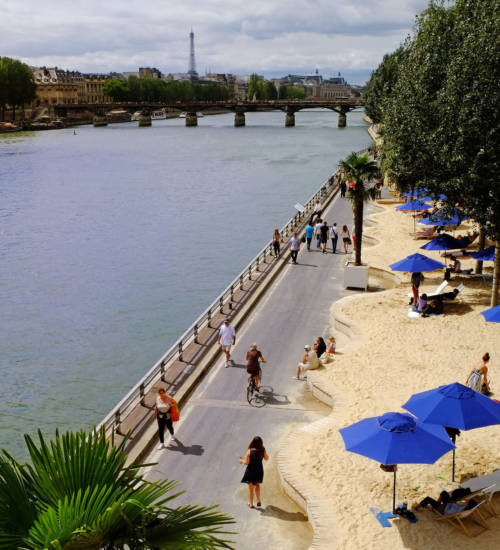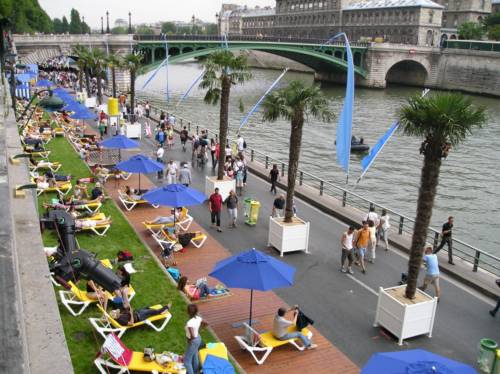Paris Turns Right Wing of Seine into Scenic Permanent Park
A new initiative in Paris is underway to turn the right bank of the Seine, one of the most iconic sites of Paris and a main expressway, into a permanent park.
For the past 15 years, Paris has been closing two of the highway lanes on the Seine to create more greenery during the summer. The “Paris Plages” essentially turns the former highways into an urban beach, with sand, green areas, and lounge spots. Since 2002, the Paris Plages provides a mini vacation for city dwellers with beach volleyball, kayaking, a mini pool, and even a temporary library to borrow books. This has served as a trial for the permanent transformation of the Seine’s right wing from the Louvre promenade to the area surrounding the Place de la Bastille.
In 1991, UNESCO recognized the banks of the Seine, from the Bir Hakeim bridge to the Ile Saint Louis, as a World Heritage Site. The head of the city’s transport policy told Reuters recently: ”We want to pedestrianize the Right Bank because we want to give this magnificent space, part of the UNESCO World Heritage, back to Parisians.”
This is Paris’s second main installment of their transformation of the Seine. In 2013, Paris permanently transformed the Seine’s left wing into a pedestrian way, a further effort to reduce the amount of cars in the city. Yet, the decision to turn the most convenient highways for getting from one end of the city to the other into a permanent pedestrian walkway is not without controversy. “Parisians are a quite nervous about this decision though as in the past 5 years or so, anti-car policies have created more congestion in many central areas” Leyla Mattison, who lives in Paris, commented.
Some Parisians said that the city should focus on improving their public transportation before closing down a main expressway. Others complained that this would make their daily tasks impossible. “I carry 15 bottles of wine with me. How would I get up the hill at Montmartre? What about winter, what about rain?” a Frenchman told Reuters. In 2013 when Paris turned the left bank into a pedestrian zone, almost identical controversy ensued.
Paris has a long relationship with monitoring vehicles, both encouraging them and limiting them. In 1967, the expressway opened by Pompidou, with the motivating idea being, “Paris must adapt to the car”. All the while, environmentalists have asserted that turning one of Paris’s most scenic and iconic landmarks into a highway only brings pollution and makes the city unattractive.
The right bank initiative is another one of the city’s efforts to reduce vehicles in what might seem like drastic ways. In July, for example, the city banned cars made before 1997 from entering the city between 8am and 8pm. In March, they banned cars with odd-number license plates from entering the city. These drastic measures were brought on to counter the high rates of pollution within the city.
Seine’s park initiative opens up a larger discussion about the tension between convenience for motor vehicles and the importance of city-wide greenery. How much should urban cities accommodate vehicles, and how much should they prioritize greenery? Recently, Slate urged U.S. cities to take note, that Paris’s blueprint for a more environmentally-friendly urban landscape can be a model for big cities like New York and Los Angeles, where it can often feel the environmental initiatives are lagging behind.




































